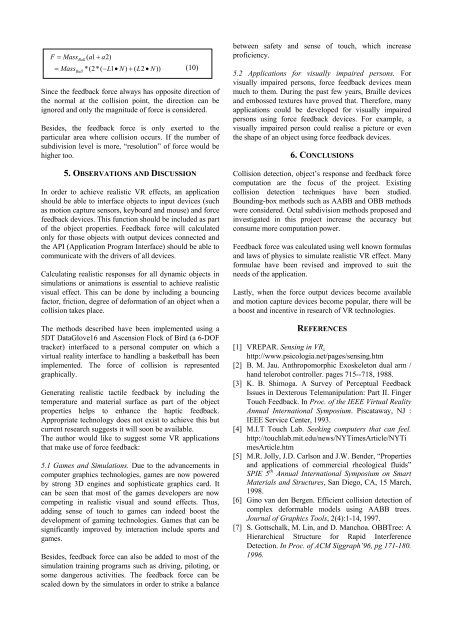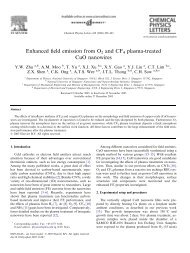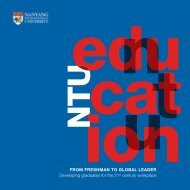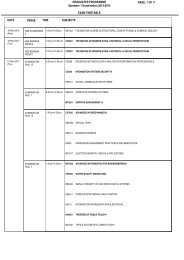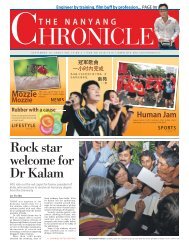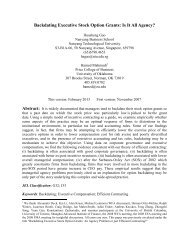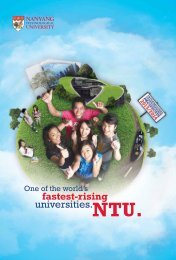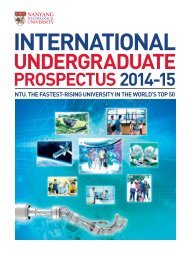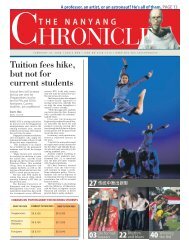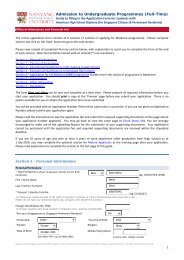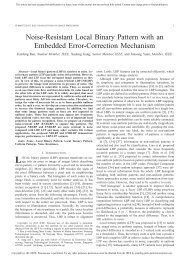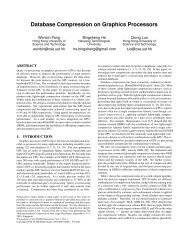Collision and Impact Force Computation for Virtual Reality ...
Collision and Impact Force Computation for Virtual Reality ...
Collision and Impact Force Computation for Virtual Reality ...
Create successful ePaper yourself
Turn your PDF publications into a flip-book with our unique Google optimized e-Paper software.
F = MassBall ( a1+ a2)= *(2*(−L1• N)+ ( L2• N))(10)Mass BallSince the feedback <strong>for</strong>ce always has opposite direction ofthe normal at the collision point, the direction can beignored <strong>and</strong> only the magnitude of <strong>for</strong>ce is considered.Besides, the feedback <strong>for</strong>ce is only exerted to theparticular area where collision occurs. If the number ofsubdivision level is more, “resolution” of <strong>for</strong>ce would behigher too.5. OBSERVATIONS AND DISCUSSIONIn order to achieve realistic VR effects, an applicationshould be able to interface objects to input devices (suchas motion capture sensors, keyboard <strong>and</strong> mouse) <strong>and</strong> <strong>for</strong>cefeedback devices. This function should be included as partof the object properties. Feedback <strong>for</strong>ce will calculatedonly <strong>for</strong> those objects with output devices connected <strong>and</strong>the API (Application Program Interface) should be able tocommunicate with the drivers of all devices.Calculating realistic responses <strong>for</strong> all dynamic objects insimulations or animations is essential to achieve realisticvisual effect. This can be done by including a bouncingfactor, friction, degree of de<strong>for</strong>mation of an object when acollision takes place.The methods described have been implemented using a5DT DataGlove16 <strong>and</strong> Ascension Flock of Bird (a 6-DOFtracker) interfaced to a personal computer on which avirtual reality interface to h<strong>and</strong>ling a basketball has beenimplemented. The <strong>for</strong>ce of collision is representedgraphically.Generating realistic tactile feedback by including thetemperature <strong>and</strong> material surface as part of the objectproperties helps to enhance the haptic feedback.Appropriate technology does not exist to achieve this butcurrent research suggests it will soon be available.The author would like to suggest some VR applicationsthat make use of <strong>for</strong>ce feedback:5.1 Games <strong>and</strong> Simulations. Due to the advancements incomputer graphics technologies, games are now poweredby strong 3D engines <strong>and</strong> sophisticate graphics card. Itcan be seen that most of the games developers are nowcompeting in realistic visual <strong>and</strong> sound effects. Thus,adding sense of touch to games can indeed boost thedevelopment of gaming technologies. Games that can besignificantly improved by interaction include sports <strong>and</strong>games.Besides, feedback <strong>for</strong>ce can also be added to most of thesimulation training programs such as driving, piloting, orsome dangerous activities. The feedback <strong>for</strong>ce can bescaled down by the simulators in order to strike a balancebetween safety <strong>and</strong> sense of touch, which increaseproficiency.5.2 Applications <strong>for</strong> visually impaired persons. Forvisually impaired persons, <strong>for</strong>ce feedback devices meanmuch to them. During the past few years, Braille devices<strong>and</strong> embossed textures have proved that. There<strong>for</strong>e, manyapplications could be developed <strong>for</strong> visually impairedpersons using <strong>for</strong>ce feedback devices. For example, avisually impaired person could realise a picture or eventhe shape of an object using <strong>for</strong>ce feedback devices.6. CONCLUSIONS<strong>Collision</strong> detection, object’s response <strong>and</strong> feedback <strong>for</strong>cecomputation are the focus of the project. Existingcollision detection techniques have been studied.Bounding-box methods such as AABB <strong>and</strong> OBB methodswere considered. Octal subdivision methods proposed <strong>and</strong>investigated in this project increase the accuracy butconsume more computation power.Feedback <strong>for</strong>ce was calculated using well known <strong>for</strong>mulas<strong>and</strong> laws of physics to simulate realistic VR effect. Many<strong>for</strong>mulae have been revised <strong>and</strong> improved to suit theneeds of the application.Lastly, when the <strong>for</strong>ce output devices become available<strong>and</strong> motion capture devices become popular, there will bea boost <strong>and</strong> incentive in research of VR technologies.REFERENCES[1] VREPAR. Sensing in VR.http://www.psicologia.net/pages/sensing.htm[2] B. M. Jau. Anthropomorphic Exoskeleton dual arm /h<strong>and</strong> telerobot controller. pages 715--718, 1988.[3] K. B. Shimoga. A Survey of Perceptual FeedbackIssues in Dexterous Telemanipulation: Part II. FingerTouch Feedback. In Proc. of the IEEE <strong>Virtual</strong> <strong>Reality</strong>Annual International Symposium. Piscataway, NJ :IEEE Service Center, 1993.[4] M.I.T Touch Lab. Seeking computers that can feel.http://touchlab.mit.edu/news/NYTimesArticle/NYTimesArticle.htm[5] M.R. Jolly, J.D. Carlson <strong>and</strong> J.W. Bender, “Properties<strong>and</strong> applications of commercial rheological fluids”SPIE 5 th Annual International Symposium on SmartMaterials <strong>and</strong> Structures, San Diego, CA, 15 March,1998.[6] Gino van den Bergen. Efficient collision detection ofcomplex de<strong>for</strong>mable models using AABB trees.Journal of Graphics Tools, 2(4):1-14, 1997.[7] S. Gottschalk, M. Lin, <strong>and</strong> D. Manchoa. OBBTree: AHierarchical Structure <strong>for</strong> Rapid InterferenceDetection. In Proc. of ACM Siggraph’96, pg 171-180.1996.


